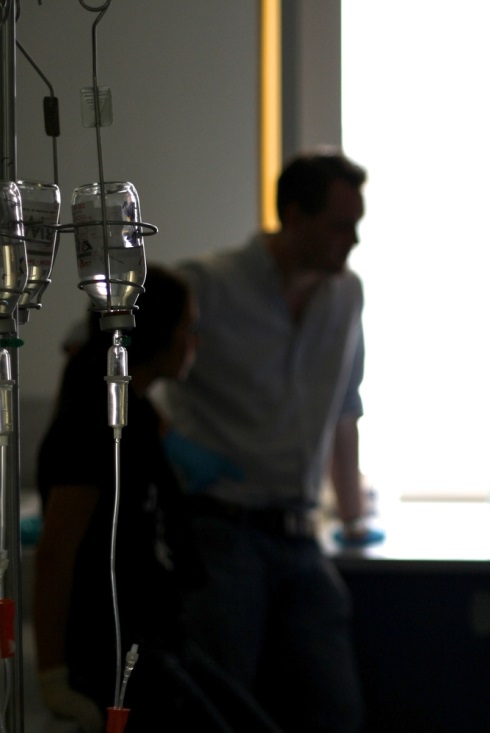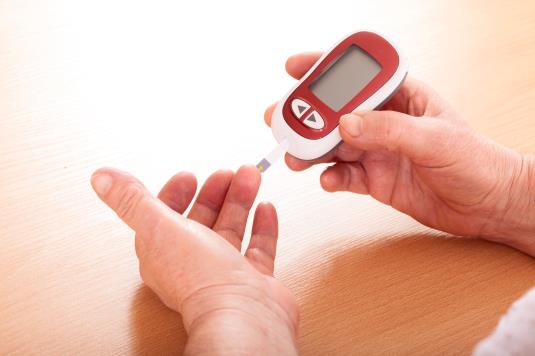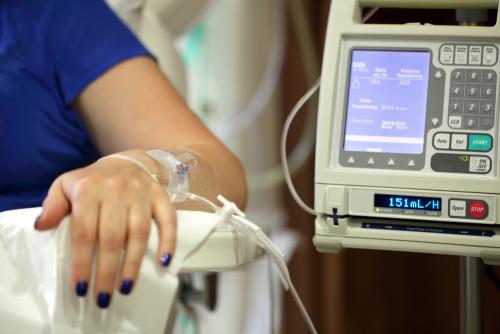What to Do When Cancer Treatment Causes Eating Problems
 Cancer treatment in general can make it hard to maintain adequate nutrition, but patients undergoing treatment for head and neck cancer in particular face a unique set of challenges. Targeted treatments seek to minimize side effects that can cause dry mouth, soreness of the mouth and throat, difficulty swallowing and mouth ulcers. But in spite of the best efforts of your treatment team, you may still experience some of these side effects.
Cancer treatment in general can make it hard to maintain adequate nutrition, but patients undergoing treatment for head and neck cancer in particular face a unique set of challenges. Targeted treatments seek to minimize side effects that can cause dry mouth, soreness of the mouth and throat, difficulty swallowing and mouth ulcers. But in spite of the best efforts of your treatment team, you may still experience some of these side effects.
When head and neck cancer treatment makes it hard to eat, you may need to change your eating habits accordingly. Soft foods and thick liquids are often easier to swallow when you’re suffering from soreness of the mouth and throat, and can even be soothing to irritated areas. At the same time, there are some foods you should avoid during head and neck cancer treatment, because they can irritate sensitive tissues. In order for head and neck cancer treatment to be a success, it’s important that you maintain proper nutrition and eat enough calories to keep up your strength.
Remember the Basics of Cancer Treatment Nutrition
When you’re having trouble chewing or swallowing your food due to the side effects of head and neck cancer treatment, the principles of good nutrition remain the same as if you were having any other kind of cancer treatment. You may need to switch to eating six to eight small meals each day instead of three big ones. You should also focus on eating calorie-dense, nutritious foods. You may not be able to eat as much as you could before you started treatment, so you need to make every mouthful count in terms of calories. Keep your diet balanced, too, by eating a variety of foods.
Make Foods Easier to Swallow
Thick liquids, like milkshakes and yogurt, can be easier to swallow than thin liquids when swallowing is difficult. You can add thickening agents, like gelatin or cornstarch, to thin soups, or use a slurry (mix of water and flour) to soften cakes and breads enough to swallow them comfortably. Use a blender or food processor to puree your meals.
Avoid Acidic, Spicy, Salty or Tart Foods
If you have soreness or ulcers in your mouth or throat, certain foods can aggravate that condition. These foods can include:
- Tart fruits and citrus fruits
- Pickled foods
- Foods, dressings and sauces containing vinegar
- Tomato-based sauces and foods
- Foods with a rough texture, like granola, toast or raw vegetables and fruits
- Spicy or peppery foods, like cloves, horseradish, chili pepper, nutmeg and hot sauces
 Use mild spices like rosemary, oregano, mint, basil and thyme to add flavor to your meals. Add calories to your diet using lean meats, peanut butter, dairy products, nuts and seeds, or liquid food supplements. If you have sores or ulcers in your mouth or throat, soft, bland foods are the way to go. Drink liquids through a straw to keep them from irritating sore areas. If you’re not sure what to eat, there are plenty of recipes designed for people going through head and neck cancer treatment available online.
Use mild spices like rosemary, oregano, mint, basil and thyme to add flavor to your meals. Add calories to your diet using lean meats, peanut butter, dairy products, nuts and seeds, or liquid food supplements. If you have sores or ulcers in your mouth or throat, soft, bland foods are the way to go. Drink liquids through a straw to keep them from irritating sore areas. If you’re not sure what to eat, there are plenty of recipes designed for people going through head and neck cancer treatment available online.
The most important thing to remember when you’re going through treatment for head and neck cancer is that you need to keep up your strength and minimize weight loss. Add calories to your diet whenever you can, to get the most out of your treatments.
More
Could Diabetes Cause Head and Neck Cancer?
 Researchers in Taiwan have recently linked diabetes with head and neck cancer, finding that the risk for such cancers is about 50 percent higher in people with diabetes than it is in people without the metabolic disease. People with diabetes between the ages of 40 and 65 are at the highest risk of all.
Researchers in Taiwan have recently linked diabetes with head and neck cancer, finding that the risk for such cancers is about 50 percent higher in people with diabetes than it is in people without the metabolic disease. People with diabetes between the ages of 40 and 65 are at the highest risk of all.
The study, which was conducted by Kuo-Shu Tseng, PhD and colleagues at Tainan University of Technology in Taiwan, looked at the records of 89,089 people with recent diabetes diagnoses. The researchers compared the data with that of control patients of similar age, gender and medical condition, but without diabetes. The data came from Taiwan’s Longitudinal Health Insurance Research Database.
Diabetes Linked to Greater Risk of Head and Neck Cancer
The researchers looked at the differences in head and neck cancer risk between groups of cohorts based on age, gender and the number of years since each patient was diagnosed with diabetes. When compared with members of a control group, rates of head and neck cancer were 1.47 times higher for patients who had been diagnosed with diabetes.
The average age of head and neck cancer diagnosis among those with diabetes was 55.52 years. The average patient was diagnosed with head and neck cancer 4.48 years after being diagnosed with diabetes. Diabetes patients aged 40 to 65 years were at the highest risk of developing head and neck cancer, while diabetic men were more likely to develop the cancer than diabetic women.
In addition to diabetes, the patients were found to suffer from other concurrent diseases including:
- Hypertension
- Obesity
- Chronic kidney disease
- Chronic obstructive pulmonary disease
- Coronary artery disease
What accounts for the link between diabetes and head and neck cancer? The researchers postulate that the two conditions could share hereditary risk factors or be linked to the same genetic mutation. It’s also possible that head and neck cancer, like breast cancer, could be the result of ongoing hyperinsulinemia, which is common in patients with Type 2 diabetes. The use of insulin may be linked to cell overgrowth. Head and neck cancer could also be the result of some other aspect of metabolic dysfunction. While more research is needed to understand the reasons for the link between diabetes and cancers of the head and neck, patients with diabetes — especially those between the ages of 40 and 65 — would do well to remain alert to possible head and neck cancer symptoms.
 Causes and Treatment of Head and Neck Cancer
Causes and Treatment of Head and Neck Cancer
Unfortunately, the researchers in this study didn’t have access to information regarding the patients’ other risk factors for head and neck cancer. Two of the biggest risk factors for these cancers are tobacco and alcohol use, although there are several occupational and other factors that can increase your risk of head and neck cancers. Human papillomavirus, or HPV, is responsible for a significant portion of head and neck cancers today.
Treatment for head and neck cancer has improved dramatically in recent years. Targeted radiation treatments now allow doctors to treat cancerous tumors of the head and neck while minimizing damage to healthy surrounding tissues. That’s good news for patients diagnosed with these cancers, since the mucous membranes of the mouth, nose and throat are particularly vulnerable to radiation treatment side effects.
Researchers in Taiwan have discovered a possible link between diabetes and head and neck cancer. Diabetic men aged 40 to 65 are at the highest risk. The good news is that these cancers are more treatable than ever. Staying alert to possible cancer symptoms could save your life.
More
Your Basic Guidebook to Prostate Cancer
 Prostate cancer is a disease that can only affect men. Unlike even breast cancer which though associated with women but can grow in both sexes, the prostate gland is as common a natural occurrence in the female body as ovaries are in men. The prostate is part of the male reproductive system and is responsible for the production of much of the volume of the seminal fluid. Cancer of the prostate gland is more commonly diagnosed than breast cancer, and it is gaining as much popularity as the pink-ribboned disease. Prostate cancer is often relatively slow growing and often shows no symptoms. In later stages, however, it can be responsible for diminished reproductive function, problems urinating, blood in the urine and pain in the back or pelvis when urinating.
Prostate cancer is a disease that can only affect men. Unlike even breast cancer which though associated with women but can grow in both sexes, the prostate gland is as common a natural occurrence in the female body as ovaries are in men. The prostate is part of the male reproductive system and is responsible for the production of much of the volume of the seminal fluid. Cancer of the prostate gland is more commonly diagnosed than breast cancer, and it is gaining as much popularity as the pink-ribboned disease. Prostate cancer is often relatively slow growing and often shows no symptoms. In later stages, however, it can be responsible for diminished reproductive function, problems urinating, blood in the urine and pain in the back or pelvis when urinating.
Risk Factors
The direct causes of prostate cancer are not entirely known but there are a few correlations to increased risk. Prostate cancer is significantly more prevalent in developed nations; however, this is largely due to the availability of medical testing increasing the rate of diagnosis. Also, race, diet, family history and obesity all can play a factor. There is a small increased risk of prostate cancer with lack of exercise.
High rates of red meat and dairy consumption increase the risk for prostate cancer. It’s possible this is due to a decrease in the rates of vegetable consumption that has a direct correlation with high red meat diets. Also, men who have a first-degree relative (father or brother) with prostate cancer are twice as likely to be diagnosed in their lifetime; this soars to five times as likely with two or more first-degree relatives diagnosed.
Survival Rates
Luckily, the five-year survival rate for prostate cancer in the United States is 99 percent. In fact, most men diagnosed with prostate cancer will die of other causes without treatment. That is, what kills them while they have prostate cancer is generally not the cancer itself. The median age of diagnosis for prostate cancer is 66 and the median age of death is 80. As with any cancer, the progression of the cancer is important for determining the treatment and survival outlook. Due to our extensive testing programs, 80.7 percent of prostate cancer diagnoses are due to the location of a tumor still within the prostate, and the five-year survival rate for local stage prostate cancer is 100 percent.
Treatment Options
The most common treatment methods for prostate cancer are watchful waiting or active surveillance. This is largely due to the comparative harmlessness most people experience with early stage, slow growth prostate cancer.  However, surgery to remove the tumor can leave the patient incontinent, due to the prostate’s proximity to the bladder, or with no natural reproductive function, which makes many men hesitant to undergo surgery. Most cases will never need surgery, and instead will use other extremely effective courses of treatment.
However, surgery to remove the tumor can leave the patient incontinent, due to the prostate’s proximity to the bladder, or with no natural reproductive function, which makes many men hesitant to undergo surgery. Most cases will never need surgery, and instead will use other extremely effective courses of treatment.
Prostate cancer is the second most commonly diagnosed cancer in the United States, which has led to dramatic increases in treatment options and survival rates in the last 40 years. However, that doesn’t mean there isn’t cause for concern. If you are diagnosed with prostate cancer, work closely with your physicians to pursue the right treatment.
More
A Basic Introduction to Lung Cancer Facts
 Lung cancer is one of the three most prevalent cancers in the U.S., along with breast and prostate cancer. Unfortunately, unlike breast cancer and prostate cancer, which affect similar numbers of people as lung cancer, lung cancer is much more deadly. Lung cancer is the leading cause of cancer-related death in the U.S. and worldwide. This is true for both men and women. In 2012, lung cancer was responsible for 1.56 million deaths. The symptoms of lung cancer include weight loss, coughing, coughing up blood, shortness of breath, fever, chest pain and difficulty swallowing, but these symptoms are common to other respiratory illnesses, so their lack of distinctness delays medical attention to the cancer until it’s too late.
Lung cancer is one of the three most prevalent cancers in the U.S., along with breast and prostate cancer. Unfortunately, unlike breast cancer and prostate cancer, which affect similar numbers of people as lung cancer, lung cancer is much more deadly. Lung cancer is the leading cause of cancer-related death in the U.S. and worldwide. This is true for both men and women. In 2012, lung cancer was responsible for 1.56 million deaths. The symptoms of lung cancer include weight loss, coughing, coughing up blood, shortness of breath, fever, chest pain and difficulty swallowing, but these symptoms are common to other respiratory illnesses, so their lack of distinctness delays medical attention to the cancer until it’s too late.
Risk Factors
The single greatest risk factor for lung cancer, by far, is long-term exposure to tobacco smoke, including secondhand exposure. Tobacco exposure accounts for 80-90 percent of lung cancer cases. The other primary risk factors are exposure to asbestos, radon gas or certain other air pollutions as well as, unfortunately, genetics. However, these only accounts for about 10-15 percent of lung cancer cases. Radon gas is a direct result of the breakdown of radium which is a product of the breakdown of uranium. It’s considerably more common in some places than others due to the prevalence or absence of radium deposits in the soil. It’s believed that air pollution accounts for about 1.5 percent of lung cancer cases. Genetic causes of lung cancer are not entirely understood, as is the case with most gene-related health issues.
Survival Rates
The five-year survival rate of lung cancer is 16.8 percent based on 2004 to 2010 statistics. Although this is truly tragic, it’s in large part because large majorities, more than 57 percent, of lung cancer cases that are discovered are in the late stages in which the cancer has metastasized. Of these cases, only 4 percent of people survive for five years. Therefore, 2.28 percent of lung cancer patients are diagnosed with late stage lung cancer and survive for five years or more.
The survival rate for individuals who are diagnosed with early stage lung cancer is 54 percent. Unfortunately, only 15 percent of cancer diagnoses are in the local stage. If we can convert even half of the late and middle stage diagnoses, which together account for a full 79 percent of all lung cancer cases, to early-stage diagnoses through regular checks and early detection, then the five-year survival rate of alllung cancer cases would rise to almost 32 percent. That is a big hypothetical completely dependent on the fact that relative survival for localized lung cancer remains static.
These statistics, 54 percent of lung cancer deaths, is an incredibly good reason for all long term smokers or secondhand smokers to get regular tests for lung cancer after the age of fifty. The average age of diagnosis is 70 while the average age at death is 72. If you or your partner has smoked for decades, get checked regularly.
 Treatment Options
Treatment Options
Perhaps the greatest tragedy is that even after successful treatment of the original tumor, the cancer may have spread to inoperable areas, necessitating alternative and less invasive options like precision radiology. Treatment options are limited in most cancer cases. Radiotherapy and chemotherapy are common treatments for the late stages of cancer. Early stage lung cancer can see surgery as effective depending on the health of the individual and the type of cancer. Ultimately, hope for survival depends on early detection, a good attitude and a capable cancer care team.
More
Kidney Cancer 101 – Risk Factors & Treatments
 There are several different types of cancer which fall under the umbrella category of kidney cancer. Of these there are two predominant types, renal cell carcinomas (RCC) and urothelial cell carcinomas (UCC). The names describe which region they originated in. RCC originated in the kidney specifically and is responsible for 90-95 percent of all cases. UCC is a cancer that can occur in other organs in the urinary system and grows out of the transitional lining of the kidneys and other hollow organs like the bladder. What’s included in the following statistics is the specific form of UCC that can be considered kidney cancer, which is called renal pelvis cancer.
There are several different types of cancer which fall under the umbrella category of kidney cancer. Of these there are two predominant types, renal cell carcinomas (RCC) and urothelial cell carcinomas (UCC). The names describe which region they originated in. RCC originated in the kidney specifically and is responsible for 90-95 percent of all cases. UCC is a cancer that can occur in other organs in the urinary system and grows out of the transitional lining of the kidneys and other hollow organs like the bladder. What’s included in the following statistics is the specific form of UCC that can be considered kidney cancer, which is called renal pelvis cancer.
Risk Factors
Factors that increase the risk of kidney cancer include smoking, obesity, family history, hepatitis C or kidney diseases which necessitate dialysis. Smoking can as much as double the risk for kidney cancer. Kidney and renal pelvis cancers combined account for approximately 3.8 percent of all new cancer diagnoses in the United States. The median age of diagnosis for kidney and renal pelvis cancer is 64 with 50 percent of diagnosed patients being between the ages of 55 and 74. Kidney and renal pelvis cancer is more common in men, and people of Asian or Pacific Islander descent are the least at-risk; other races are pretty evenly at risk.
Survival Rates
About 72.4 percent of those diagnosed with kidney or renal pelvis cancer will survive for five years or more. This is largely because most diagnoses are still at the local stage, and the survival rate for the local stage is 91.8 percent. The five- year survival rate for regional kidney and renal pelvis cancers is 64.6 percent. Stage-3 has a 12.1 percent five-year survival rate. This cancer is responsible for approximately 14,000 deaths per year in the United States. The median age at death for kidney and renal pelvis cancer is 71. It should be noted that every case is different and each individual should discuss these survival rates with their doctor.
Treatment Options
Treatments for kidney cancer are dependent upon the stage of the disease but surgery is typically the fallback treatment. Chemotherapy and radiotherapy are not usually used as kidney cancers do not often respond to such treatment. Sometimes in surgery the entire kidney is removed but most tumors are amenable to a partial removal, or removal of only the infected area. However, surgery isn’t always possible as the tumor may have spread or there may be preexisting conditions that prevent this. Kidney cancer sufferers should talk to their doctors about viable alternatives to surgery.
Kidney cancer, like other forms of cancer death rates, is dependent on the stage in which it’s discovered. The most common symptoms are blood in urine, flank pain and weight loss. Diagnosis often takes into account a range of biochemical tests that may use blood or urine to analyze any differences in electrolytes, renal and liver function and blood clotting patterns. Physical examination may reveal an unidentified mass or an enlarged organ. As with many other cancers active surveillance is often the first step in treatment.
More
 Cancer treatment in general can make it hard to maintain adequate nutrition, but patients undergoing treatment for head and neck cancer in particular face a unique set of challenges. Targeted treatments seek to minimize side effects that can cause dry mouth, soreness of the mouth and throat, difficulty swallowing and mouth ulcers. But in spite of the best efforts of your treatment team, you may still experience some of these side effects.
Cancer treatment in general can make it hard to maintain adequate nutrition, but patients undergoing treatment for head and neck cancer in particular face a unique set of challenges. Targeted treatments seek to minimize side effects that can cause dry mouth, soreness of the mouth and throat, difficulty swallowing and mouth ulcers. But in spite of the best efforts of your treatment team, you may still experience some of these side effects. Use mild spices like rosemary, oregano, mint, basil and thyme to add flavor to your meals. Add calories to your diet using lean meats, peanut butter, dairy products, nuts and seeds, or liquid food supplements. If you have sores or ulcers in your mouth or throat, soft, bland foods are the way to go. Drink liquids through a straw to keep them from irritating sore areas. If you’re not sure what to eat, there are plenty of recipes designed for people going through head and neck cancer treatment available online.
Use mild spices like rosemary, oregano, mint, basil and thyme to add flavor to your meals. Add calories to your diet using lean meats, peanut butter, dairy products, nuts and seeds, or liquid food supplements. If you have sores or ulcers in your mouth or throat, soft, bland foods are the way to go. Drink liquids through a straw to keep them from irritating sore areas. If you’re not sure what to eat, there are plenty of recipes designed for people going through head and neck cancer treatment available online.





 Treatment Options
Treatment Options
